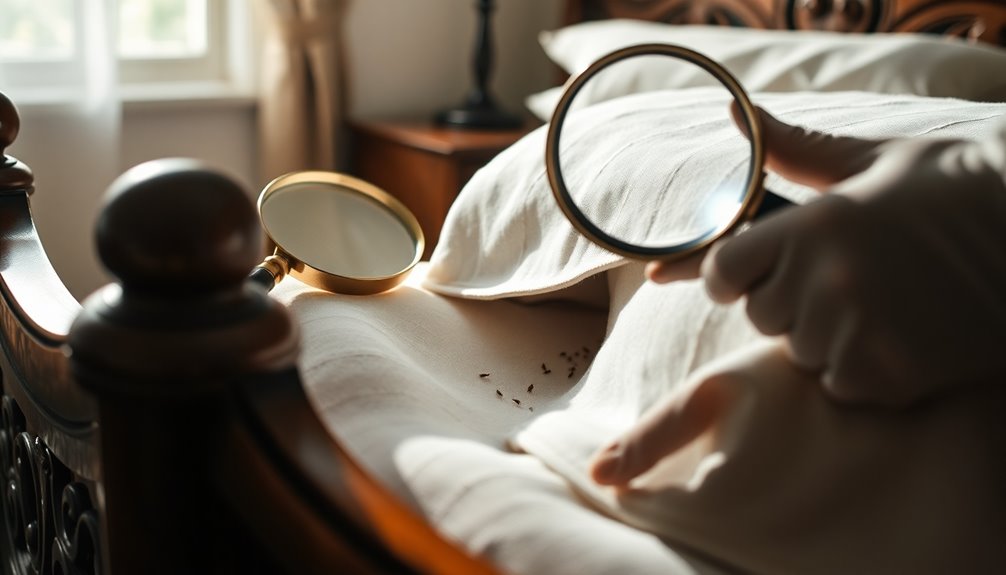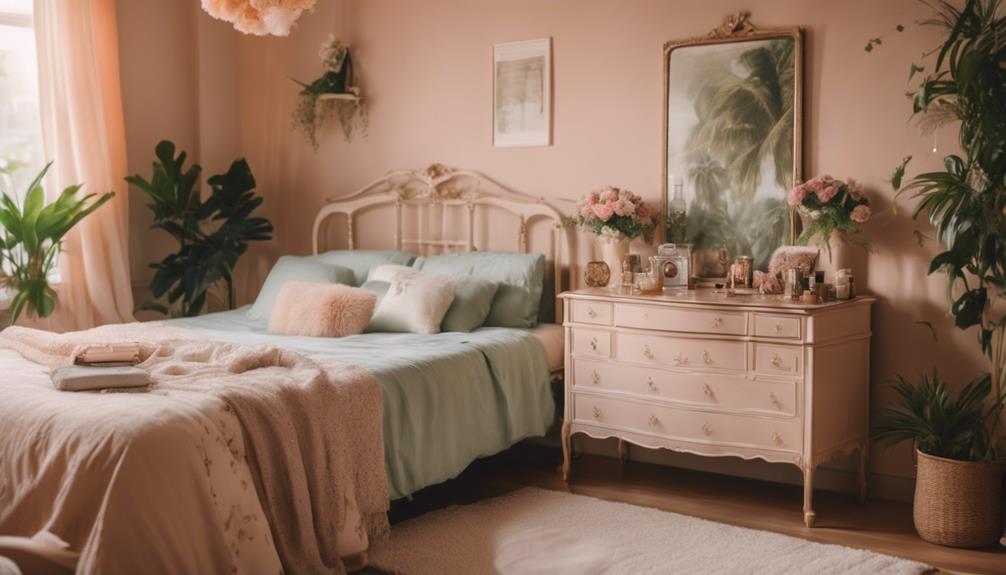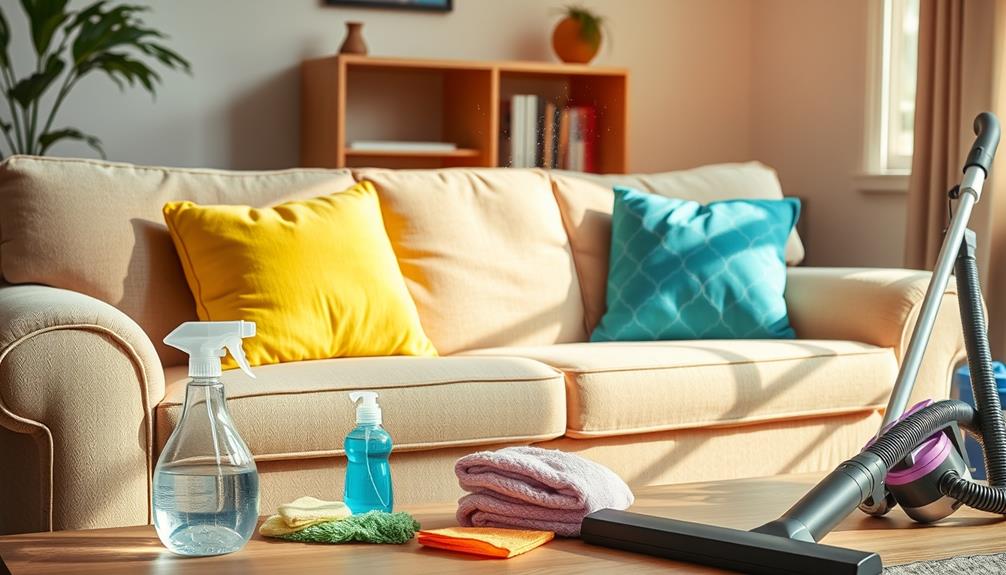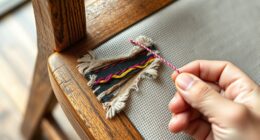To check your furniture for bed bugs, focus on seams, folds, and hidden areas like between cushions. Inspect mattresses, upholstered pieces, and even inside drawers. Look for small black dots (fecal matter), white spots (eggs or shed skins), and adult bugs that are oval and reddish-brown. Use a flashlight to help spot signs. Don't forget to check electrical outlets and behind items on walls. If you find fecal marks or bite signs, you may have an infestation. Regular inspections can catch issues early, and there's much more you can do to protect your home.
Key Takeaways
- Inspect seams, folds, and hidden areas of upholstered furniture, including between cushions, for signs of bed bugs or fecal matter.
- Use a flashlight to enhance visibility while checking under furniture and within drawers for live bugs, eggs, or shed skins.
- Look for tiny black dots (fecal marks) and reddish-brown stains that indicate recent bed bug activity on surfaces.
- Keep furniture away from walls and seal cracks to limit bed bug access and potential hiding spots.
- Consider hiring pest control experts for thorough inspections and effective treatment if signs of bed bugs are found.
Inspection Areas
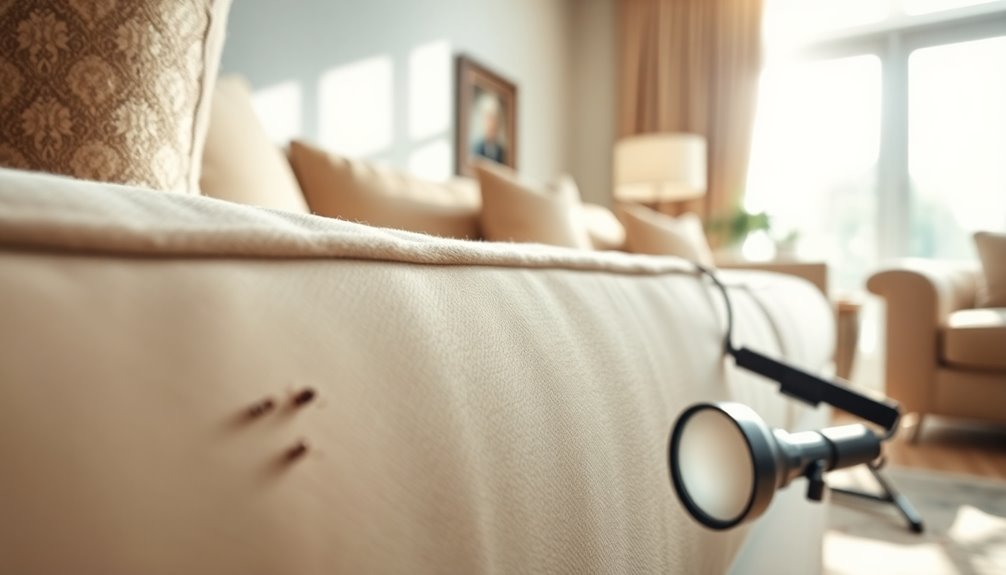
When you're checking for bed bugs, it's crucial to focus on specific inspection areas throughout your home. Start with your bedding and mattresses. Remove the bedding and closely inspect the seams and folds of your mattress and box spring. Make sure to check the underside of the box spring, removing the fabric if possible, and don't forget the piping and seams.
Next, turn your attention to upholstered furniture. Check the seams and folds of your sofas, couches, and plush chairs. Make sure to look between couch pillows and within chair seams, examining the frames and under cushions. Soft surfaces in homes, including cushions and fabric folds, are potential hiding places for bed bugs. To prevent infestations, consider thoroughly vacuuming upholstered items before storing them away, as this will help eliminate any hidden pests. Additionally, researching how to protect furniture during storage is essential; using airtight containers or protective covers can deter pests from taking up residence in your belongings. Regularly inspecting your furniture and being proactive about cleaning can significantly reduce the risk of bringing bed bugs into your home.
Don't overlook drawers and storage areas. Inspect the drawers in bedside tables and dressers, especially inside and along the sides. Remove contents and place them in plastic bags for inspection. Jewelry boxes and cardboard storage should also be checked.
Finally, inspect other areas like electrical outlets, light switches, and picture frames. Look behind items on the walls and check window coverings. Thoroughly examining these inspection areas will help you catch any potential bed bug issues before they escalate.
Signs of Bed Bugs
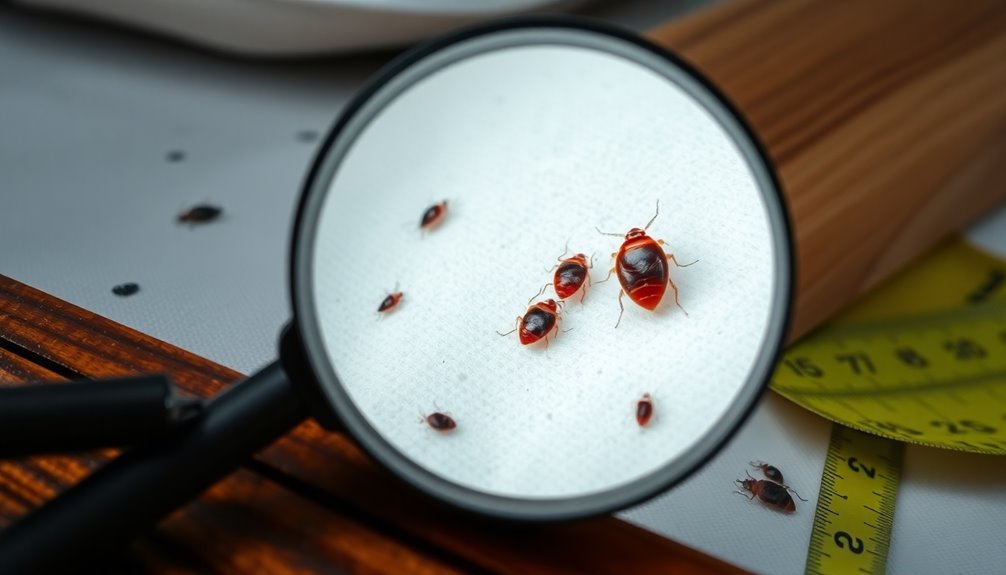
Recognizing the signs of bed bugs is essential for early detection and prevention of an infestation. Start by checking for small black dots that resemble bed bug droppings. You might find these under tables or near seams of furniture. They can also appear as dark stains or smears, indicating digested blood.
Next, look for white spots that could be bed bug eggs or shed skin. These are shaped like grains of rice but are smaller and translucent, often pearly-white and shiny. You're likely to find them in seams, cushions, and other hidden areas, pointing to recent bed bug activity.
Keep an eye out for adult bed bugs, about ¼ inch long, oval, reddish-brown, and wingless. They're flat with long, slender legs and antennae. Immature bed bugs, or nymphs, are smaller and lighter in color. You may also notice molted shells as they grow. One or two bed bugs can initiate an infestation, which can become significant in a short time as they reproduce quickly.
Additionally, look for red or swollen welts on your skin after sleeping, or detect a sweet, musty odor, which signals a larger infestation. These signs help you identify bed bugs before they become a serious problem.
Fecal Marks and Stains
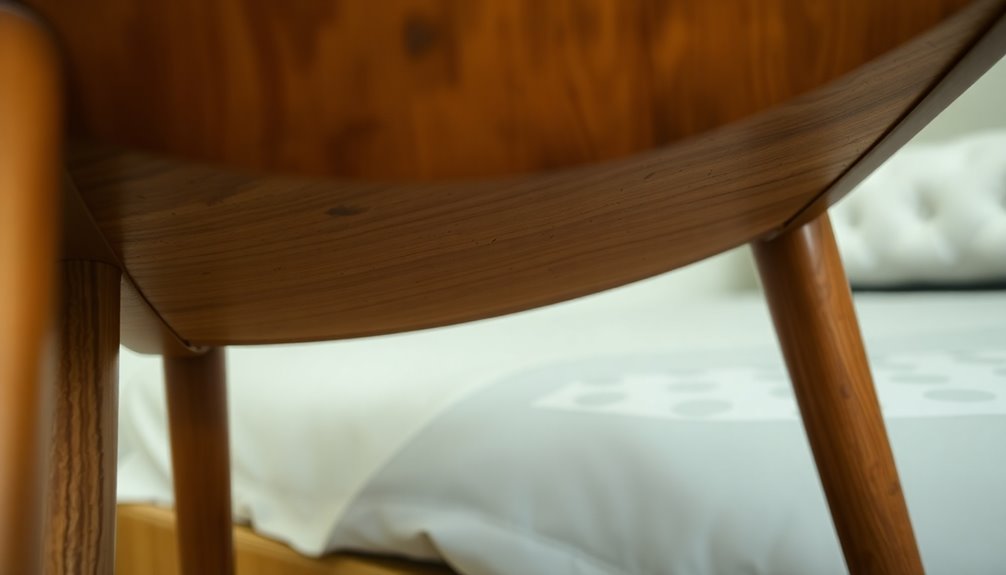
Fecal marks and stains are clear indicators of bed bug activity that you shouldn't overlook. These marks typically appear as small black dots or specks, often grouped together in clusters of ten or more. When inspecting your furniture, focus on mattress seams, folds, and crevices, as well as the underside of the box spring and corners. You should also check the headboard, particularly behind it, and examine the cracks and joints of the bed frame. Don't forget to look at couches and upholstered furniture, concentrating on seams and cushions.
Fresh fecal marks can have a semi-liquid texture, while dried marks feel smooth to the touch. To distinguish bed bug fecal stains from others, take note that reddish-brown stains indicate blood from recent feedings. If you're uncertain, use alcohol wipes on the marks; if they turn red or reddish-brown, it's likely bed bug feces. Keep in mind that bed bug fecal marks can be differentiated from German cockroach feces by the presence of additional evidence, like shed skins or hatched eggs. Additionally, exposure to bed bug feces can lead to allergic reactions, making vigilant inspection even more crucial. Stay vigilant to protect your home from these pests!
Other Indicators
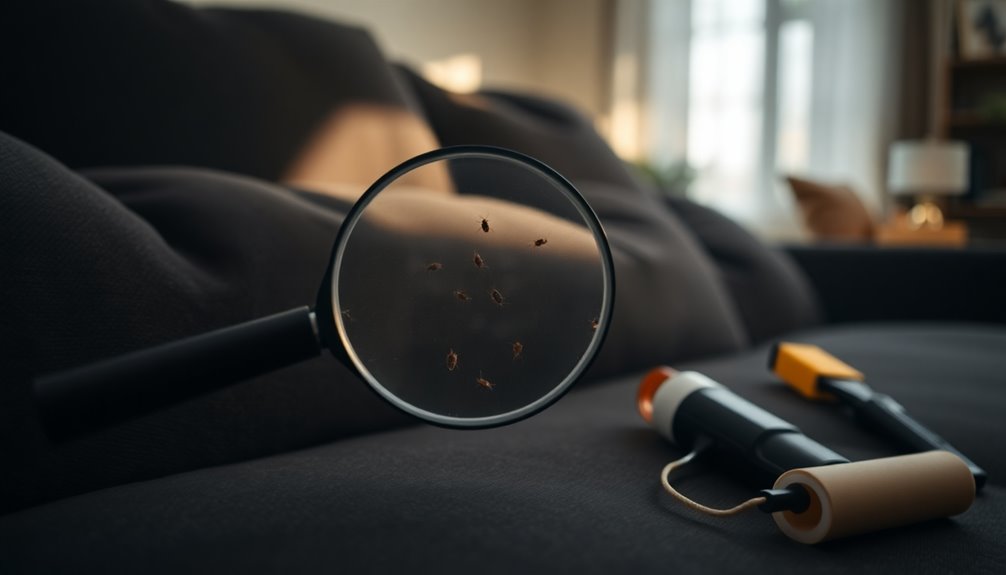
You might not realize it, but there are several other indicators that can help you identify bed bug infestations in your furniture. First, look for live bed bugs, which are reddish-brown, oval-shaped, and about the size of an apple seed after feeding. If you spot them during the day, it could mean a heavy infestation. Dead bed bugs often hide in the same spots, so check those areas too.
Another sign to watch for is bed bug eggs and eggshells. These tiny, pearly white eggs, about 1 millimeter in size, are typically found in clusters and can be hard to see. If you notice white or yellowish shells, it means bed bugs have hatched in your furniture. Female bed bugs can lay 200-500 eggs over a 10-month lifespan, which highlights the urgency of addressing an infestation quickly.
Don't overlook shed skins, either. As bed bugs grow, they shed their skins, leaving behind light-colored flakes in hidden areas like seams and crevices. Their presence suggests ongoing activity.
Lastly, a musty odor in wood furniture or raised bumps on surfaces can signal an infestation. Bite marks on you or dark spots along cracks also indicate that bed bugs may be present. Stay vigilant!
Inspection Techniques
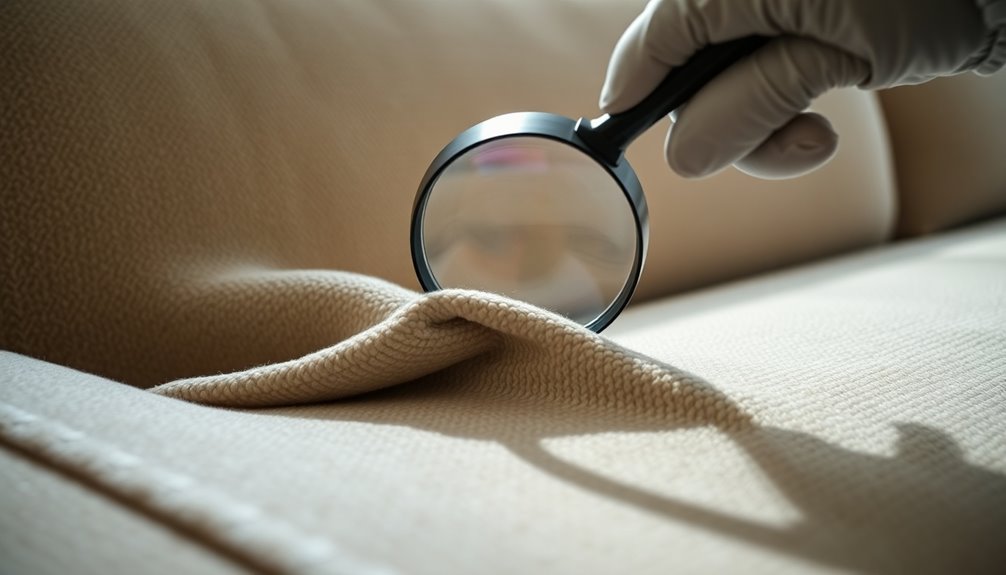
When checking furniture for bed bugs, using effective inspection techniques is crucial for identifying potential infestations. Start by gathering your inspection tools: a flashlight, magnifying glass, gloves, and a container for any suspicious items. Having someone to help move furniture is also a good idea.
Begin your inspection by examining all seams, cracks, and crevices in the furniture. Don't forget to check fabric rips and tears, zippers, and the underside of the pieces. Remove drawers to inspect the drawer cavity thoroughly. Lift the dust cover on the bottom of furniture and pull apart folds to check for any hidden bugs. Be particularly vigilant for evidence of bed bug feces, as these small black dots can indicate an infestation.
Don't overlook areas under cushions and in crevices; vacuum these spots while inspecting. Make sure to check the inner surfaces of mattresses and box springs, as well as the outer surfaces of nightstands and dressers. Move furniture away from walls to access hidden spots, and empty and clean any drawers or compartments. Finally, inspect electronics and areas around outlets, as bed bugs can hide in these locations too. Thorough inspections will help you catch any potential infestations early.
Preventive Measures
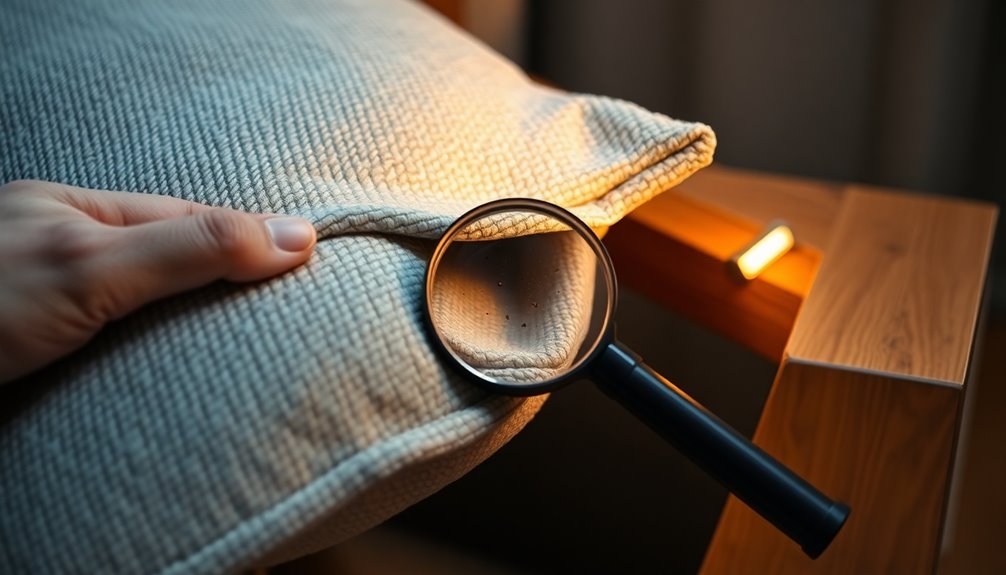
Taking proactive steps is essential to prevent bed bugs from hitching a ride into your home with new furniture. First, always check secondhand furniture for signs of infestation. Look for small black feces near seams, eggs, or shed skin. Don't hesitate to ask previous owners about the furniture's history. If you're unsure after inspecting, consider heat treating it to eliminate any hidden pests. It's crucial to remember that infestation can take approximately one month to establish after bed bugs have entered your home, so vigilance is key.
Investing in protective covers for your mattress and box springs is another smart move. Choose high-quality, tear-resistant encasements and regularly inspect them for damage. Light-colored covers can help you spot any potential bed bugs more easily.
To minimize hiding spots, reduce clutter in your home. Seal any cracks and crevices around baseboards and light sockets with silicone caulk. Keep furniture away from walls and avoid letting linens touch the floor. Installing door sweeps can deter bed bugs from moving around.
Finally, maintain cleanliness by vacuuming frequently with a HEPA filter to capture any stray bugs. Empty the vacuum outside promptly and wash your bedding in hot water. Using a steam cleaner on fabrics can also help eliminate any lurking pests.
Frequently Asked Questions
How Long Can Bed Bugs Survive Without a Host?
Bed bugs can survive for quite a while without a host, depending on their life stage and environmental conditions. Adults can live up to 400 days without feeding in optimal conditions, while younger nymphs usually last only 2-3 months. Generally, in typical home environments, you'll find they survive for about six months. Humidity and temperature also play a big role in their longevity, affecting how long they can go without a meal.
Can Bed Bugs Live in Furniture Without Being Visible?
Yes, bed bugs can hide in furniture without being visible. They prefer cracks, crevices, and seams, making it easy for them to go unnoticed. You might find them lurking behind headboards or inside upholstery. Even if you don't see them, signs like tiny dark spots or shed skins could indicate their presence. Staying vigilant and inspecting your furniture regularly can help you catch any infestations before they become a bigger problem.
What to Do if I Find Bed Bugs in My Furniture?
If you find bed bugs in your furniture, act quickly. Start by vacuuming the infested area thoroughly, including seams and crevices. Next, apply a bed bug-specific insecticide to affected spots. Disassemble any furniture to clean hidden areas and inspect for eggs or molts. Seal any cracks and consider using protective covers on mattresses. It's crucial to continue treatments every week until you're sure the infestation's eliminated. Don't let them spread!
Are Bed Bugs Harmful to Pets or Humans?
Yes, bed bugs can be harmful to both pets and humans. In humans, you might experience allergic reactions like itchy welts or severe symptoms in rare cases. Pets may feel discomfort or anxiety from bites, though direct harm is rare. The stress of dealing with an infestation can also affect you and your pets mentally. It's crucial to monitor your living space for signs of these pests to maintain a healthy environment for both.
How Often Should I Inspect Furniture for Bed Bugs?
You should inspect your furniture regularly, especially if you live in a high-risk area or have traveled recently. A monthly schedule works well for DIY inspections, while professional ones can be done quarterly. If you've dealt with bed bugs before, increase the frequency. Look for signs like tiny black spots or shed skins. Staying proactive helps you catch any issues early and prevents a larger infestation down the line.
Conclusion
In conclusion, regularly inspecting your furniture for bed bugs is essential to keep your home pest-free. Check all the areas we discussed, and pay close attention to any signs like fecal marks or shed skins. By being vigilant and using the right techniques, you can catch these pests early and prevent a larger infestation. Don't forget to implement preventive measures to protect your space. Stay proactive, and you'll sleep soundly without worrying about these unwanted guests!
